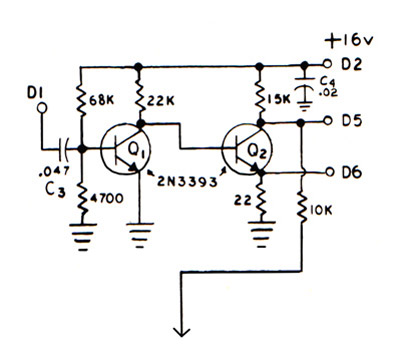X 66
North Suburban HAMMOND ORGAN Service
Tone Wheel Generator Signal Synchronizer.

Figure 8.
The signals from the tone wheel generator are approximately sine wave signals and they are of very low amplitude, only about 0.02 volts RMS. The synchronizer is actually an amplifier, and it also changes these signals to square waves.
In operation, the signal from the appropriate tonewheel generator coil enters the synchronizer on terminal D1 through the .047uF capacitor listed as C3. To make this simpler to reproduce, I am using the original Hammond company part number designations. Note that the signal appears on the base of transistor Q1, is amplified there and appears on the base of transistor Q2 to be amplified further. The signal on Q2 collector (terminal D5) goes on to the appropriate keyer for that particular note. The signal at terminal D6 goes to the appropriate percussion keyer. A portion of the signal also goes through the 10 K resistor (attached to the wire for terminal D5) and goes out along the wire which terminates with an arrow. This is the input to the first frequency divider.
In converting the approximate sinewave input from the tone generator to a square wave, this amplifying circuit is actually "clipping" the waveform which action in conventional amplification would normally result in severe distortion. However, it handles only one particular frequency. Therefore, the clipping is not only not a problem, but is actually a benefit in that the essentially square wave which this circuit outputs is more useful for the subsequent circuitry in the organ than it would be if it were a sinewave. There are twelve of these synchronizing amplifiers, and each handles only one frequency. Therefore, they can clip the waveform significantly and yet the severe distortion caused by the clipping is not only not a problem but is actually beneficial.
At this point it is worth stating that some electronic organs such as the traditional Hammonds use keyed audio, that is, the key switches actually apply the audio signals to the appropriate following circuitry. Other instruments, such as the Wurlitzer 4600 series, are keyed generator instruments, where the keys control the operating voltage to the tone generators. In keyed audio instruments the audio signals are being generated all the time. In keyed generator instruments, the audio signals only exist when particular tone generating elements are keyed or turned on by DC operating voltages from the playing keys. A further subcategory of keyed audio is that of electronically keyed audio, where the keys control DC voltages which turn on the appropriate audio keying circuits which then let the audio signals proceed through the subsequent circuitry of the instrument.
The big disadvantage of directly keying audio signals is that the instrument tends to take on a "telegraph key" effect with tones beginning and ending instantly, often with an audible key click or pop. Electronically keyed audio and keyed generator instruments are free of this major flaw. The X66 is, with respect to the drawbars, the percussion section and the pedals, an electronically keyed audio instrument and as such is musically superior to the traditional Hammonds. The formanted voices are directly keyed audio, but as we shall later see, serious key clicks are not such a serious, big problem when keying sawtooth waveforms into formant filters as they are when sine-wave signals are keyed directly.
Previous Page Page 7. Next page